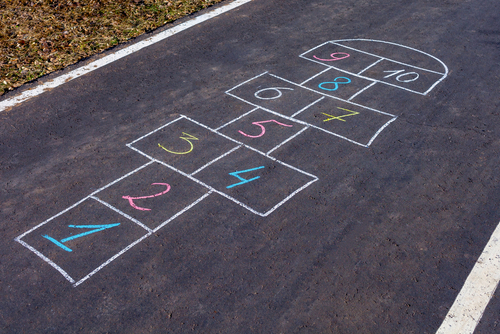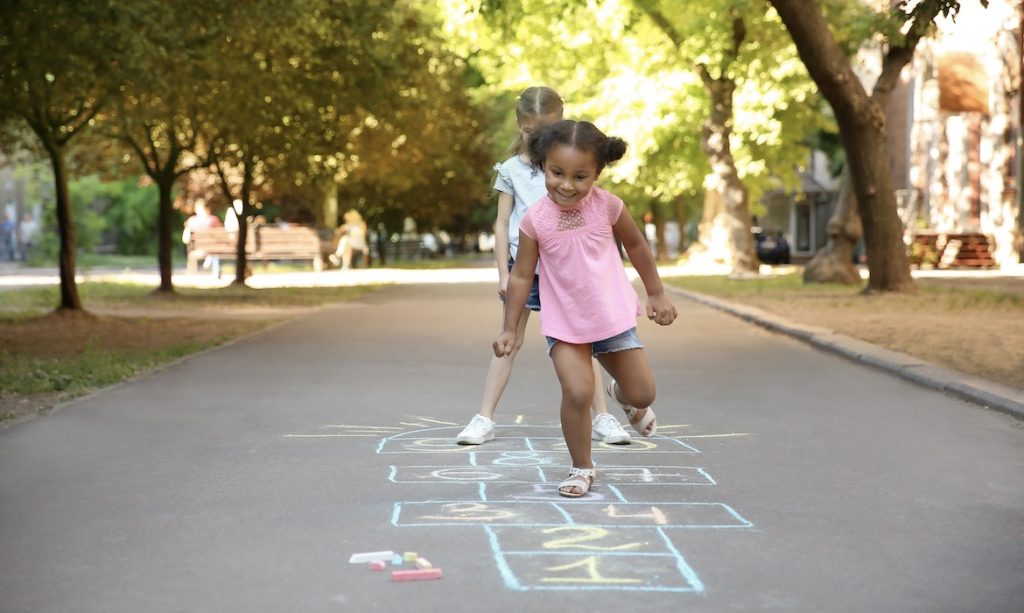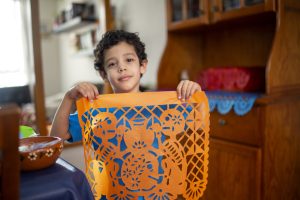Hopscotch is a fun outdoor game enjoyed around the world and across generations. It’s also a great way to explore early math ideas!
Stroll through your neighborhood park and you might see hopscotch courts inviting you and your children to hop along. Hopscotch is also easy to create with sidewalk chalk. In a traditional hopscotch game, children hop through landing spaces numbered one through 10. Players call out the numbers they pass through as they hop. They can also toss a small object, like a stone, into a space that children then hop to collect.
Use a hopscotch court you find or create your own to develop children’s math thinking. Having conversations about math supports young children’s mathematical learning. In this blog, we share tips for having conversations about math while keeping hopscotch interesting and challenging.
Hopscotch Supports Early Math Learning

In hopscotch, the numbers go in order but not always in a straight line—some numbers are positioned side-by-side. Players land on one foot in single spaces and land in side-by-side spaces with two feet, one foot in each space. These movements offer opportunities to talk about space and place.
While playing, children practice the counting sequence and seeing and naming numerals. They build number relations knowledge by figuring out what number comes next and how far away one number is from another. If playing by tossing a stone, children pick up the stone and hop over the space it landed on. For example, if the stone lands on 4, children hop to 3, pick up the stone from 4, and then hop over 4 to land on 5. When stopping to pick up the stone, children practice counting on from a number other than one.
Draw Out the Math in Your Hopscotch Court
Hopscotch offers lots of flexibility to create your own court and play by your own rules. Ask children questions to gain insights into their thinking about key math ideas. Here are examples of math conversations you can have while creating your hopscotch court:
- SHAPE: What shape should we use for our landing spaces? What makes this four-sided shape a square? What is this three-sided shape called?
- SIZE: How can we make sure the spaces are big enough to hop on? Can you think of a way to make the spaces all the same size? (Measure using informal units like sidewalk tiles, a stick, or foot length walking end-to-end. Emphasize that the measuring unit needs to stay the same to be meaningful.)
- MEASUREMENT: How far is our court from the beginning to end? Let’s measure it!
- DISTANCE: How far can you hop? This helps us decide how big to make each landing space.
- PATTERN: What patterns can we make using different colors/shapes for the spaces?
- COUNTING: Will we draw up to 5, 10, or 12? Let’s check that the numbers are in the right order and that we didn’t skip a number.
Play and Build Math Knowledge
Support children’s learning with these ideas for talking about math while playing hopscotch:
- Encourage children to count aloud as they hop from one to the end. Then add a twist by having them count backward as they hop from the end to one (10, 9, 8…).
- Leave some spaces blank so children must think about what number comes next.
- Ask children to count how many spaces come before them and how many they have left to reach the end.
- Use words that highlight space and place, such as “near” and “far.”
- Introduce skip counting by 2s or 5s to reach the end.
- Add variation and challenge with the ideas in this PDF.
What hopscotch variations do your children get excited about? Share them with us at contactdreme@stanford.edu



